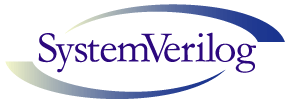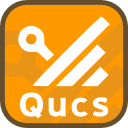Related Research Articles

VHDL is a hardware description language used in electronic design automation to describe digital and mixed-signal systems such as field-programmable gate arrays and integrated circuits. VHDL can also be used as a general-purpose parallel programming language.
Verilog, standardized as IEEE 1364, is a hardware description language (HDL) used to model electronic systems. It is most commonly used in the design and verification of digital circuits at the register-transfer level of abstraction. It is also used in the verification of analog circuits and mixed-signal circuits, as well as in the design of genetic circuits. In 2009, the Verilog standard was merged into the SystemVerilog standard, creating IEEE Standard 1800-2009. Since then, Verilog is officially part of the SystemVerilog language. The current version is IEEE standard 1800-2017.
In computer engineering, a hardware description language (HDL) is a specialized computer language used to describe the structure and behavior of electronic circuits, and most commonly, digital logic circuits.
The IEEE 1164 standard is a technical standard published by the IEEE in 1993. It describes the definitions of logic values to be used in electronic design automation, for the VHDL hardware description language. It was sponsored by the Design Automation Standards Committee of the Institute of Electrical and Electronics Engineers (IEEE). The standardization effort was based on the donation of the Synopsys MVL-9 type declaration.
Property Specification Language (PSL) is a temporal logic extending linear temporal logic with a range of operators for both ease of expression and enhancement of expressive power. PSL makes an extensive use of regular expressions and syntactic sugaring. It is widely used in the hardware design and verification industry, where formal verification tools and/or logic simulation tools are used to prove or refute that a given PSL formula holds on a given design.
In digital circuit design, register-transfer level (RTL) is a design abstraction which models a synchronous digital circuit in terms of the flow of digital signals (data) between hardware registers, and the logical operations performed on those signals.
SystemC is a set of C++ classes and macros which provide an event-driven simulation interface. These facilities enable a designer to simulate concurrent processes, each described using plain C++ syntax. SystemC processes can communicate in a simulated real-time environment, using signals of all the datatypes offered by C++, some additional ones offered by the SystemC library, as well as user defined. In certain respects, SystemC deliberately mimics the hardware description languages VHDL and Verilog, but is more aptly described as a system-level modeling language.

SystemVerilog, standardized as IEEE 1800, is a hardware description and hardware verification language used to model, design, simulate, test and implement electronic systems. SystemVerilog is based on Verilog and some extensions, and since 2008 Verilog is now part of the same IEEE standard. It is commonly used in the semiconductor and electronic design industry as an evolution of Verilog.

The Wishbone Bus is an open source hardware computer bus intended to let the parts of an integrated circuit communicate with each other. The aim is to allow the connection of differing cores to each other inside of a chip. The Wishbone Bus is used by many designs in the OpenCores project.

Quite Universal Circuit Simulator (Qucs) is a free-software electronics circuit simulator software application released under GPL. It offers the ability to set up a circuit with a graphical user interface and simulate the large-signal, small-signal and noise behaviour of the circuit. Pure digital simulations are also supported using VHDL and/or Verilog.
Verilog-AMS is a derivative of the Verilog hardware description language that includes analog and mixed-signal extensions (AMS) in order to define the behavior of analog and mixed-signal systems. It extends the event-based simulator loops of Verilog/SystemVerilog/VHDL, by a continuous-time simulator, which solves the differential equations in analog-domain. Both domains are coupled: analog events can trigger digital actions and vice versa.
In computer science, the double dabble algorithm is used to convert binary numbers into binary-coded decimal (BCD) notation. It is also known as the shift-and-add-3 algorithm, and can be implemented using a small number of gates in computer hardware, but at the expense of high latency.
e is a hardware verification language (HVL) which is tailored to implementing highly flexible and reusable verification testbenches.
C to HDL tools convert C language or C-like computer code into a hardware description language (HDL) such as VHDL or Verilog. The converted code can then be synthesized and translated into a hardware device such as a field-programmable gate array. Compared to software, equivalent designs in hardware consume less power and execute faster with lower latency, more parallelism and higher throughput. However, system design and functional verification in a hardware description language can be tedious and time-consuming, so systems engineers often write critical modules in HDL and other modules in a high-level language and synthesize these into HDL through C to HDL or high-level synthesis tools.
Flow to HDL tools and methods convert flow-based system design into a hardware description language (HDL) such as VHDL or Verilog. Typically this is a method of creating designs for field-programmable gate array, application-specific integrated circuit prototyping and digital signal processing (DSP) design. Flow-based system design is well-suited to field-programmable gate array design as it is easier to specify the innate parallelism of the architecture.

Electronic circuit simulation uses mathematical models to replicate the behavior of an actual electronic device or circuit. Simulation software allows for modeling of circuit operation and is an invaluable analysis tool. Due to its highly accurate modeling capability, many colleges and universities use this type of software for the teaching of electronics technician and electronics engineering programs. Electronics simulation software engages its users by integrating them into the learning experience. These kinds of interactions actively engage learners to analyze, synthesize, organize, and evaluate content and result in learners constructing their own knowledge.
Value Change Dump (VCD) is an ASCII-based format for dumpfiles generated by EDA logic simulation tools. The standard, four-value VCD format was defined along with the Verilog hardware description language by the IEEE Standard 1364-1995 in 1996. An Extended VCD format defined six years later in the IEEE Standard 1364-2001 supports the logging of signal strength and directionality. The simple and yet compact structure of the VCD format has allowed its use to become ubiquitous and to spread into non-Verilog tools such as the VHDL simulator GHDL and various kernel tracers. A limitation of the format is that it is unable to record the values in memories.
Aldec, Inc. is a privately owned electronic design automation company based in Henderson, Nevada that provides software and hardware used in creation and verification of digital designs targeting FPGA and ASIC technologies.
The Design Automation Standards Committee (DASC) is a subgroup of interested individuals members of the Institute of Electrical and Electronics Engineers (IEEE) Computer Society and Standards Association. It oversees IEEE Standards that are related to computer-aided design. It is part of the IEEE Computer Society.

In computing, an arithmetic logic unit (ALU) is a combinational digital circuit that performs arithmetic and bitwise operations on integer binary numbers. This is in contrast to a floating-point unit (FPU), which operates on floating point numbers. It is a fundamental building block of many types of computing circuits, including the central processing unit (CPU) of computers, FPUs, and graphics processing units (GPUs).
References
- ↑ http://www.myhdl.org/
- ↑ http://docs.myhdl.org/en/stable/manual/conversion.html
- ↑ http://docs.myhdl.org/en/stable/whatsnew/0.6.html#conversion-of-test-benches
- ↑ http://docs.myhdl.org/en/stable/whatsnew/0.6.html#conversion-of-lists-of-signals
- ↑ http://docs.myhdl.org/en/stable/whatsnew/0.6.html#conversion-output-verification
- ↑ http://docs.myhdl.org/en/stable/manual/cosimulation.html
- ↑ http://www.linuxjournal.com/article/7542
- ↑ http://docs.myhdl.org/en/stable/manual/conversion_examples.html